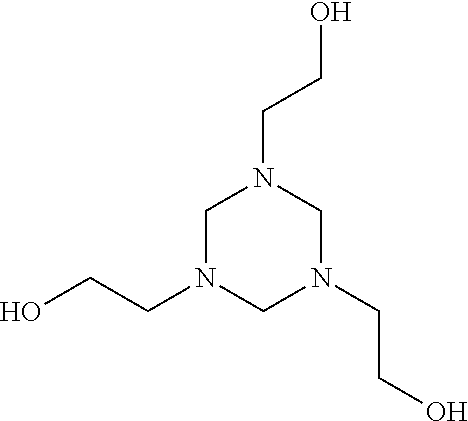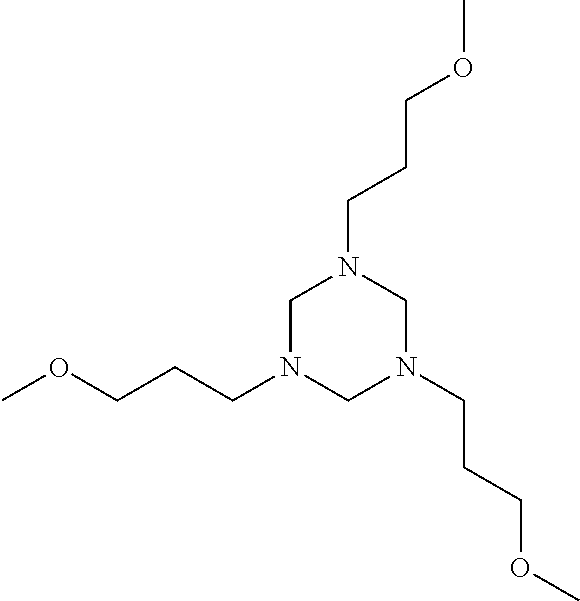Hexahydrotriazines, synthesis and use
a technology of hexahydrotriazines and triazines, applied in the field of synthesis and use of hexahydrotriazines, can solve the problems of high flammability, increased cost to purchase and ship symmetrical triazines used in these areas, and less effective as an hsub>2
- Summary
- Abstract
- Description
- Claims
- Application Information
AI Technical Summary
Benefits of technology
Problems solved by technology
Method used
Image
Examples
example 1
[0018]Example 1 utilizes a mixture of two or more primary amines, monoethanolamine (MEA) and methoxypropylamine (MOPA). The molar ratio of MEA to MOPA is 2:1 but the molar ratio may vary. In Example 1, the asymmetrical triazine was made in a flask equipped with a stirrer, condenser, and temperature control device. The flask was charged with 1 Mole (31.25 gm) of 96% pure paraformaldehyde. The primary amines were premixed in a separate container. The primary amine mixture included 0.66 Mole (40.26 gm) monoethanolamine (MEA) and 0.34 (30.0 gm) of methoxypropylamine (MOPA). The primary amine mixture was then added drop-wise to the flask containing the paraformaldehyde while controlling the temperature in the flask to below 50° C. After the mixture was added, the contents of the flask were stirred for 1 hour while the temperature of the flask was maintained at 80° C. After one hour, 102 grams of asymmetrical triazine was collected. The product was a transparent single phase solution. The...
example 2
[0019]The efficacy of the product produced in Example 1 was tested in Example 2. In this example, 200 ml of a light hydrocarbon mixture having 2000 ppm of H2S level in the head space was placed in a 1-liter bottle. Next, 5500 ppm of the asymmetrical triazine produced in Example 1 was added to the 1-liter bottle. After stirring for 30 minutes at room temperature, the H2S level in the head space was reduced to 100 ppm.
example 3
[0020]In this example, 200 ml of a light hydrocarbon mixture having 2000 ppm of H2S level in the head space was placed in a 1-liter bottle. Next, 6500 ppm of the asymmetrical triazine produced in Example 1 was added to the 1-liter bottle. After stirring for 30 minutes at room temperature, the H2S level in the head space was reduced to 6 ppm.
PUM
 Login to View More
Login to View More Abstract
Description
Claims
Application Information
 Login to View More
Login to View More - R&D
- Intellectual Property
- Life Sciences
- Materials
- Tech Scout
- Unparalleled Data Quality
- Higher Quality Content
- 60% Fewer Hallucinations
Browse by: Latest US Patents, China's latest patents, Technical Efficacy Thesaurus, Application Domain, Technology Topic, Popular Technical Reports.
© 2025 PatSnap. All rights reserved.Legal|Privacy policy|Modern Slavery Act Transparency Statement|Sitemap|About US| Contact US: help@patsnap.com



